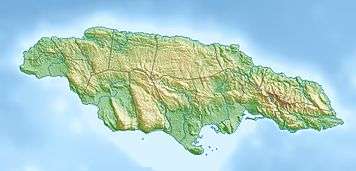Jamaican ibis
| Jamaican ibis | |
|---|---|
| Scientific classification | |
| Kingdom: | Animalia |
| Phylum: | Chordata |
| Class: | Aves |
| Order: | Pelecaniformes |
| Family: | Threskiornithidae |
| Subfamily: | Threskiornithinae |
| Genus: | Xenicibis |
| Species: | X. xympithecus |
| Binomial name | |
| Xenicibis xympithecus | |
 | |
The Jamaican ibis, Jamaican flightless ibis[1] or clubbed-wing ibis[2] (Xenicibis xympithecus) is an extinct bird species of the ibis subfamily uniquely characterized by its club-like wings.[3] It is the only species in the genus Xenicibis,[1] and one of only two flightless ibis genera,[2][3] the other being the genus Apteribis endemic to Hawaii.[2][4]

Description
The species was first described in 1977 based on postcranial bone elements excavated in a cave deposit at Long Mile Cave, Jamaica, by H. E. Anthony in 1919–20.[1][5] At the time, it was presumed to be flightless based on the incomplete coracoid;[1] its flightlessness was confirmed after a humerus of the same species was found in the Swansea Cave, Jamaica.[5][6] New fossil finds from two locations, including the Red Hills Fissure, show that the bird has a unique modification of the carpometacarpus rendering it club-like.[3] The metacarpal is enlarged and bowed distally with thickened walls, while the ulna and radius have been modified as well. This was a large ibis, weighing about 2 kg (70 oz).[3]
Clubbed wing function
Ornithologists speculate that the wings were used as weapons, in the manner of a club or flail,[3] similar to the adaptations found in some mantis shrimps (Stomatopoda: Gonodactyloidea) that possess a club-like distally inflated dactyl used to strike prey and other shrimps.[7] However, among birds, this adaption appears to be unique.[3] Adaptations of the wing to fight in birds is an example of contingency in which various bird species find different solutions to the same problem based in chance.[3][8]
Distribution

The Jamaican ibis was endemic to Jamaica. Bones have been excavated from several caves, including the Long Mile Cave,[1] the Swansea Cave,[6] the Jackson's Bay Cave[9] and the Red Hills Fissure.[3] Bones from Cuba claimed to be of this genus[10] were later identified as those of a limpkin. Jamaica and Cuba have always been separated by the sea, so it is improbable that a flightless species could reach the other islands.[5]
References
- 1 2 3 4 5 Olson, Storrs L; Steadman, David W (1977). "A new genus of flightless ibis (Threskiornithidae) and other fossil birds from cave deposits in Jamaica". Proceedings of the Biological Society of Washington, 90(2): 447–457.
- 1 2 3 Tyrberg, Tommy (2009). "Holocene avian extinctions". In Turvey, Sam. Holocene Extinctions. Oxford University Press. pp. 63–106. ISBN 978-0-19-953509-5.
- 1 2 3 4 5 6 7 8 Longrich, N. R.; Olson, S. L. (2011). "The bizarre wing of the Jamaican flightless ibis Xenicibis xympithecus: a unique vertebrate adaptation". Proceedings of the Royal Society B: Biological Sciences. doi:10.1098/rspb.2010.2117.
- ↑ Olson, Storrs L.; Wetmore, Alexander (1976). "Preliminary diagnoses of two extraordinary new genera of birds from Pleistocene deposits in Hawaiian Islands." (PDF). Proceedings of the Biological Society of Washington. 89: 247–258. Retrieved January 7, 2011.
- 1 2 3 Suárez, William (2001) "Deletion of the flightless ibis Xenicibis from the fossil record of Cuba". Caribbean Journal of Science 37 (1–2): 109–110
- 1 2 Olson, Storrs L; Steadman, David W (1979) "The humerus of Xenicibis, the extinct flightless ibis of Jamaica". Proceedings of the Biological Society of Washington, 92: 23–27.
- ↑ Patek, S. N.; Korff, W. L.; Caldwell, R. L. (2004). "Biomechanics: Deadly strike mechanism of a mantis shrimp". Nature. 428 (6985): 819–20. Bibcode:2004Natur.428..819P. doi:10.1038/428819a. PMID 15103366.
- ↑ Gould, Stephen J (1989). Wonderful Life: The Burgess Shale and the Nature of History. New York: W. W. Norton. p. 347. ISBN 0-393-02705-8.
- ↑ McFarlane, D A; Lundberg, J; Fincham, A G (August 2002). "A late Quaternary paleoecological record from caves of southern Jamaica, West Indies" (PDF). Journal of Cave and Karst Studies. 64 (2): 117–125.
- ↑ Arredondo, Oscar (1984). "Sinopsis de las aves halladas en depósitos fosilíferos pleisto-holocénicos de Cuba". Reporte de Investigación del Instituto de Zoología (in Spanish). 17: 1–3.